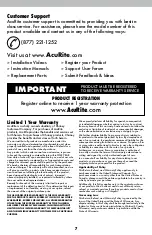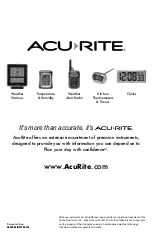
3
Search for Available Sensors
Once the repeater is powered on (switches turned to ON in the battery
compartment), it will begin searching for sensors transmitting the corresponding
ID for 5-10 minutes. If you wish to connect a sensor after the initial 5-10 minute
search, press and release the "Search" button in the battery compartment to
manually search for sensors within range.
Connecting one sensor
1. Relocate the sensor near the repeater and take note of the A-B-C channel.
All compatible sensors have an A-B-C channel, except monitors (models
00275 and 00276) which use channel ID "P" on the repeater.
2. Turn ON the corresponding channel ID switch for this sensor in the battery
compartment of the repeater.
3. Wait for the channel's LED indicator to flash, confirming that the sensor is
connected and is transmitting the sensor's signal.
Connecting multiple sensors
1. Of your available sensors, determine which ones need their wireless signal
repeated. Relocate those sensors near the repeater. Take note of the A-B-C
channels. All compatible sensors have an A-B-C channel, except monitors
(models 00275 and 00276) which use channel ID "P" on the repeater.
2. Turn ON the corresponding channel ID switches for these sensors in the
battery compartment of the repeater.
3. Wait for the LED indicator to flash* for each active repeater, confirming that
the sensors are connected and are transmitting the sensor's signal.
*If the repeater has connected to more than one sensor with the same channel
ID, the LED indicates how many sensors with that channel ID are being
repeated:
• One flash: Indicates that one sensor was repeated.
• Two flashes: Indicates that the second of two sensors was repeated.
• Three flashes: Indicates that the third of three sensors was repeated.
NOTE:
You may connect up to 3 sensors per channel ID, however for best
results, use separate A-B-C channel IDs for sensors that include this setting.
Refer to the corresponding sensor manual for instructions on setting the A-B-C
channel.


























